
|
Tissue Engineering(組織工程)
From Wikipedia, the free
encyclopedia(維基百科)
Translated By : The Analytical Based Development Center
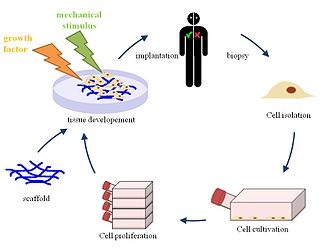
Principle of tissue engineering
組織工程的原理
Tissue engineering is
the use of a combination of cells, engineering and
materials methods, and suitable biochemical and
physicochemical factors to improve or replace biological functions.
While it was once categorized as a sub-field of biomaterials, having grown in scope and importance it can be considered
as a field in its own right.
組織工程是利用細胞, 工程以及材料方法和合適的生物化學和物理化學因素的組合, 以改善或取代的生物學功能.
雖然一度被歸類為生物材料的一個子領域,
在範圍和重要性的成長,
它可以適當地被考慮為自己一個領域.
While most definitions of tissue engineering cover a broad range of
applications, in practice the term is closely associated with applications that
repair or replace portions of or whole tissues (i.e., bone, cartilage, blood
vessels, bladder, skin,muscle etc.).
Often, the tissues involved require certain mechanical and structural properties
for proper functioning.
雖然大多數組織工程的定義涵蓋了廣泛的應用範圍,
在實務中,
這個術語是與修復或更換的部分或全部的組織(即,
骨,
軟骨,
血管,
膀胱,
皮膚,
肌肉等)的應用緊密關聯.
通常,
所涉及的組織需要用於適當運作的一定機械和結構性質.
The term has also been applied to efforts to perform specific biochemical
functions using cells within
an artificially-created support system (e.g. an artificial
pancreas,
or a bio
artificial liver).
The term regenerative
medicine is
often used synonymously with tissue engineering, although those involved in regenerative
medicine place
more emphasis on the use of stem
cells or progenitor
cells to
produce tissues.
這個詞也被應用到使用細胞在人工創造的支持系統(如人工胰腺,
或生物人工肝)內,
以呈現
特定的生化功能的努力上.
再生醫學這個術語經常被同義地用於組織工程,
但涉及再生醫學的那些更著重於用幹細胞或祖細胞以產生組織.
Contents目錄
1. Overview概述
2. Examples例子
3. Cells as building blocks細胞做為建構組件
3.1 Extraction萃取
3.2 Types of cells細胞的類型
4. Scaffolds支架
4.1 Materials材料
4.2 Synthesis
合成
5. Assembly methods裝配方法
5.1 Self-assembly自組裝
5.2 Liquid-based template assembly液基模板組裝
5.3 Additive manufacturing增材製造
5.4 Scaffolding支架製作
6. Tissue culture組織培養
6.1 Bioreactors生物反應器
6.2 Long fiber generation長纖維的產製
6.3 Bioartificial organs生物人工器官
7. See also參見
8. Notes注意事項
9. References參考
10. External links外部鏈接
Overview
概述
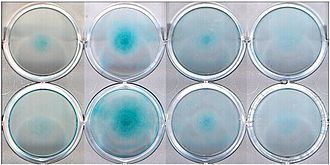
Micro-mass cultures of C3H-10T1/2 cells at varied oxygen tensions stained with Alcian blue
不同的氧張力的C3H-10T1/2細胞的微量培養—以Alcian blue染色.
A
commonly applied definition of tissue engineering, as stated by Langer[1] and Vacanti,[2] is "an interdisciplinary field that applies the principles of engineering and life sciences toward the
development of biological substitutes that restore, maintain, or improve tissue function
or a whole organ".[3]
Tissue engineering has also been defined as "understanding the principles of
tissue growth, and applying this to produce functional replacement tissue for
clinical use."[4]
組織工程的一個普遍適用的定義,
如Langer[1]和Vacanti所述, [2]
是“應用工程和生命科學的原理於恢復,
保持或改善組織功能或整個器官的生物替代品的開發的一個跨學科領域“. [3]
組織工程也被定義為“理解組織生長的原理,
並應用此以產生臨床用的功能替代組織.”[4]
A further description goes on to say that an "underlying supposition of tissue
engineering is that the employment of natural biology of the system will allow
for greater success in developing therapeutic strategies aimed at the
replacement, repair, maintenance, and/or enhancement of tissue function."[4]
進一步的說明接著說,
“組織工程的基本假設是,
這個系統的自然生物學的運用,
將允許針對組織的更換,
維修,
保養和/或功能的增強等的治療策略的開發取得更大的成功“.
[4]
Powerful developments in the multidisciplinary field of tissue engineering have
yielded a novel set of tissue replacement parts and implementation strategies.
Scientific advances in biomaterials,
stem cells, growth and differentiation factors, and biomimetic environments have created unique opportunities to fabricate tissues in the
laboratory from combinations of engineered extracellular matrices ("scaffolds"),
cells, and biologically active molecules.
在組織工程的多學科領域的強大發展已經產生了一套全新的組織替換零件和實施策略.
科學在生物材料,
幹細胞,
生長和分化因子,
和仿生環境的進步已經創造了在實驗室裏
從工程改造的細胞外基質(“支架”),
細胞,
以及生物活性分子的組合以製造組織,
的唯一的機會.
Among the major challenges now facing tissue engineering is the need for more
complex functionality, as well as both functional and biomechanical stability in
laboratory-grown tissues destined for transplantation.
The continued success of tissue engineering, and the eventual development of
true human replacement parts, will grow from the convergence of engineering and
basic research advances in tissue, matrix, growth factor, stem cell, and
developmental biology, as well as materials science and bio informatics.
In 2003, the NSF published
a report entitled "The Emergence of Tissue Engineering as a Research Field",
which gives a thorough description of the history of this field.
[5]
組織工程現在面臨的主要挑戰是更複雜功能的需要,
以及以移植為目的實驗室培養的組織的功能和生物力學兩者的穩定性.
組織工程的持續成功,
以及真實的人的更換零件的最終發展,
將從在組織,
基質,
生長因子,
幹細胞和發育生物學,
以及材料科學和生物資訊學等的工程和基礎研究的發展的合流得到成長.
在2003年,
美國國家科學基金會發表了題為
“組織工程作為一個研究領域的誕生.
”,
這給了這個領域的歷史一個徹底的描述
[5]
Examples例子
·
Bioartificial windpipe : The first procedure of regenerative medicine of an implantation of a
"bioartificial" organ.
生物人工氣管:
再生醫療的
”生物人工”
器官植入的第一個程序.
·
In vitro meat: Edible artificial animal muscle tissue cultured in vitro.
試管(體外)肉:體外培養的食用的人工動物肌肉組織.
·
Bioartificial liver device:
several research efforts have produced hepatic assist devices utilizing living
hepatocytes.
生物人工肝裝置:一些研究的努力,
已經利用活肝細胞產生肝臟輔助裝置.
·
Artificial pancreas:
research involves using islet
cells to produce and regulate insulin, particularly in cases of
diabetes.
人工胰腺:研究包括使用胰島細胞以產生及調節胰島素,
特別是在糖尿病的情況.
·
Artificial bladders: Anthony
Atala[6] (Wake Forest University)
has successfully implanted artificially grown bladders into seven out of
approximately 20 human test subjects as part of a long-term experiment.[7]
人工膀胱:Anthony
Atala[6] (Wake Forest University)
已成功植入人工生長的膀胱到約出自20位中的七位受試者,
作為長期的實驗的一部分[7].
·
Cartilage: lab-grown tissue was successfully used to repair knee cartilage.[8]
軟骨:實驗室培養的組織被成功用於修復膝蓋軟骨[8]
·
Scaffold-free cartilage:
Cartilage generated without the use of exogenous scaffold material. In this
methodology, all material in the construct is cellular or material produced
directly by the cells themselves.[9]
無支架軟骨:不使用外源支架材料所產生的軟骨.
在這種方法,
在構建體內的所有材料是細胞或直接由細胞本身製造的材料. [9]
·Doris
Taylor's heart in a jar
Doris Taylor的在一個罐子裡的心臟
·Tissue-engineered airway[10]
組織工程的氣道[10]
·Tissue-engineered vessels[11]
組織工程血管[11]
·Artificial
skin constructed from human skin cells embedded in a hydrogel, such as in the case of bio-printed constructs for battlefield burn repairs.[12]
人工皮膚:
從包埋在水凝膠裏的人體皮膚細胞構建的,
例如用於戰場燒傷修復的生物列印構建體的情況下. [12]
·
Artificial bone
marrow[13]
人造骨髓[13]
·Artificial
bone
人造骨
·Artificial penis[14]
人造陰莖[14]
·Oral mucosa tissue engineering
口腔粘膜組織工程
·Foreskin[15]
包皮[15]
Cells as building blocks
細胞作為建構組件
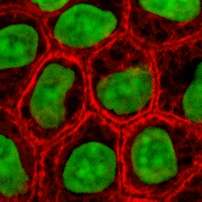
Stained cells in culture在培養中的染色的細胞
Tissue engineering utilizes living cells as engineering materials. Examples
include using living fibroblasts in skin replacement or repair, cartilage repaired
with living
chondrocytes,
or other types of cells used in other ways.
組織工程利用活細胞作為工程材料.
實例包括使用活的成纖維細胞,
在皮膚的更換或修復,
以活軟骨細胞修復的軟骨,
或以其他方式使用的其它類型的細胞.
Cells became available as engineering materials when scientists at Geron Corp.
discovered how to extend telomeres in 1998, producing immortalized cell lines.[citation needed]
Before this, laboratory cultures of healthy, noncancerous mammalian cells would
only divide a fixed number of times, up to the Hayflick limit.
細胞變得可作為工程材料,
當在Geron公司的科學家於1998年發現如何延長端粒,
產生永生細胞系.
在此之前,
實驗室培養的健康,
非癌的哺乳動物細胞只能分化一固定次數,
最高到Hayflick limit上限.
Extraction萃取
From fluid tissues such as blood,
cells are extracted by bulk methods, usually
centrifugation or apheresis.
From solid tissues, extraction is more difficult. Usually the tissue is minced,
and then digested with the enzymes trypsin or collagenase to remove the extracellular matrix that holds the cells. After that, the cells are free floating, and extracted
using centrifugation or apheresis.
Digestion with trypsin is very dependent on temperature. Higher temperatures
digest the matrix faster, but create more damage.
Collagenase is less temperature dependent, and damages fewer cells, but takes
longer and is a more expensive reagent.
從流體組織如血,
將細胞通是過整體的方法,
通常是離心或血液分離萃取.
從固體組織,
提取是比較困難的.
通常組織被切碎,
然後用酶胰蛋白酶或膠原酶消化,
以除去保存細胞的細胞外基質.
在此之後,
該細胞是自由浮動的,
並使用離心分離或血液分離萃取.
用胰蛋白酶消化是非常依賴於溫度.
溫度愈高,
消化基質愈快,
但產生出更多的損害.
膠原酶較少依賴於溫度的,
並且對細胞的損害較少,
但需要更長的時間,
並且是更昂貴的試劑.
Types of cells
細胞類型
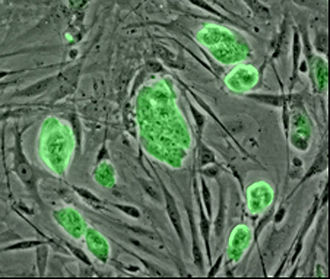
Mouse embryonic stem cells
小鼠胚胎幹細胞
Cells are often categorized by their source:
細胞通常以其來源作歸類:
·
Autologous cells are obtained from the same individual to which they will be re-implanted.
自體細胞是從它們將被重新植入的同一個體獲得.
Autologous cells have the fewest problems with rejection and pathogen
transmission, however in some cases might not be available.
For example in genetic
disease suitable autologous cells are not available.
Also very ill or elderly persons, as well as patients suffering from severe
burns, may not have sufficient quantities of autologous cells to establish
useful cell lines.
自體細胞有最少的排斥和病原體傳播的問題,
但是,
在某些情況下可能無法取得.
例如,
在遺傳病適合自體細胞是不可用.
而且重病或老年人,
以及患有嚴重燒傷的病人,
可能不具有足夠數量的自體細胞以建立有用的細胞系.
Moreover since this category of cells needs to be harvested from the patient,
there are also some concerns related to the necessity of performing such
surgical operations that might lead to donor site infection or chronic pain.
Autologous cells also must be cultured from samples before they can be used:
this takes time, so autologous solutions may not be very quick.
此外,
因為這類細胞需要從患者穫取,
也有與執行這樣的手術可能導致供體的部位感染或慢性疼痛的必要性的一些相關的關注.
自體細胞在可以使用之前,
也必須從樣品培養:這需要時間,
因此,
自體的解決方案可能不會非常快.
Recently there has been a trend towards the use of mesenchymal stem
cells from bone
marrow and fat.
These cells can differentiate into a variety of tissue types, including bone, cartilage, fat,
and nerve.
A large number of cells can be easily and quickly isolated from fat, thus
opening the potential for large numbers of cells to be quickly and easily
obtained.
最近經有了對於使用從骨髓和脂肪的間充質幹細胞的趨勢.
這些細胞能夠分化成多種組織類型,
包括骨骼,
軟骨,
脂肪,
和神經.
大量的細胞可以從脂肪容易且迅速地分離,
從而打開了快速而容易地得到大量細胞的潛能.
·
Allogeneic cells come from the body of a donor of the same species.
While there are some ethical constraints to the use of human cells for in vitro studies, the employment of dermal fibroblasts from human foreskin has been demonstrated to be immunologically safe and thus a
viable choice for tissue engineering of skin.
同種異體細胞來自相同物種的供體的身體.
雖然在使用人類細胞的體外研究有一些道德約束的,
來自於人的包皮的真皮成纖維細胞的使用,
已被證明是免疫學上安全的,
因此對皮膚的組織工程是的可行的選擇.
·
Xenogenic cells are these isolated from individuals of another species. In particular
animal cells have been used quite extensively in experiments aimed at the
construction of cardiovascular implants.
異種細胞是這些從另一個物種的個體分離得到的.
特別是動物細胞已被十分廣泛地使用於旨在心血管植入物建構的實驗.
·
Syngenic or isogenic cells are isolated from genetically
identical organisms, such as twins, clones, or highly inbred research animal
models.
同基因或等基因細胞是從遺傳上相同的生物,
如雙胞胎,
無性系,
或高度近交的研究的動物模型中分離.
·
Primary cells are from an organism.
主細胞是來自生物體.
·
Secondary cells are from a cell bank.
次級細胞是來自一個細胞庫.
·
Stem cells are undifferentiated cells with the ability to divide in culture and give rise to
different forms of specialized cells.
According to their source stem cells are divided into "adult" and "embryonic"
stem cells, the first class being
multipotent and the latter mostly pluripotent; some cells are totipotent, in the earliest stages of the embryo.
幹細胞是未分化的細胞,
具有在中培養中分裂,
並產生不同形式的特化細胞的能力.
根據它們的來源,
幹細胞被分為“成人”和“胚胎”幹細胞,
第一類是多能分化性,
後者多為超多能分化性;
有些細胞是全能分化性,
在胚胎的早期階段.
While there is still a large ethical debate related with the use of embryonic
stem cells, it is thought that another alternative source - induced stem cells may be useful for the repair of diseased or damaged tissues, or may be used to
grow new organs.
由於胚胎幹細胞的使用,
仍然有較大的倫理爭論,
它被認為是另一種替代來源 --
誘導的幹細胞對於患病或受損組織的修復是可以是有用的,
或者可以被用於生長新的器官.
Scaffolds支架
Cells are often implanted or 'seeded' into an artificial structure capable of
supporting three-dimensional tissue formation.
These structures, typically called scaffolds, are often critical, both ex
vivo as well as in
vivo, to recapitulating the in vivo
milieu and allowing cells to influence their own microenvironments.
Scaffolds usually serve at least one of the following purposes:
細胞通常被植入或“接種”進入到能夠支持三維組織形成的人工結構內.
這些結構,
通常被稱為支架,
通常是關鍵的,
既在體外以及在體內,
以重點代表體內的環境,
並允許細胞影響自身的微環境.
支架通常服務於至少下列目的中的一個:
·
Allow cell attachment and
migration
允許細胞附著和遷移
·
Deliver and retain cells and
biochemical factors
提供和保留細胞和生物化學因子
·
Enable diffusion of vital
cell nutrients and expressed products
使生命細胞的營養物質和表達產物能擴散
·
Exert certain mechanical and
biological influences to modify the behaviour of the cell phase
發揮某些機械和生物的影響以修改細包層次的行為
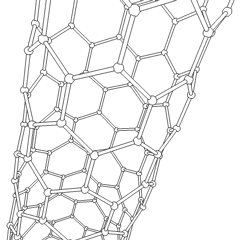
This animation of a rotating Carbon
nanotube shows its 3D structure. Carbon nanotubes are among the numerous candidates for
tissue engineering scaffolds since they are biocompatible, resistant to
biodegradation and can be functionalized with biomolecules. However, the possibility of toxicity with non-biodegradable nano-materials is
not fully understood.[16]
這個旋轉碳奈米管的動畫展示其3D結構.
碳奈米管是眾多的候選組織工程支架之一,
因為它們是生物相容的,
耐生物降解以及可以被生物分子官能化.
然而,
非生物可降解奈米材料的毒性的可能性是未被充分的理解的.
[16]
To achieve the goal of tissue reconstruction, scaffolds must meet some specific
requirements.
A high porosity and an adequate pore size are necessary to facilitate cell
seeding and diffusion throughout the whole structure of both cells and
nutrients.
Biodegradability is often an essential factor since scaffolds should preferably be absorbed by the
surrounding tissues without the necessity of a surgical removal.
為達成組織重建的目標,
支架必須滿足某些特定的要求.
高孔隙率和適當的孔徑是必要的,
以促進細胞接種以及細胞和營養素兩者遍及整體結構的擴散.
生物可降解性通常是一個重要的因素,
因為支架應優選由周圍組織所吸收,
沒有手術移的必要性.
The rate at which degradation occurs has to coincide as much as possible with
the rate of tissue formation: this means that while cells are fabricating their
own natural matrix structure around themselves, the scaffold is able to provide
structural integrity within the body and eventually it will break down leaving
the neotissue, newly formed tissue which will take over the mechanical load.
降解發生的速率需盡可能與組織形成的速率重合:這意味著當細胞正製造圍繞其自身的天然基質結構時,
支架能夠在身體內提供結構完整性,
並最終它將分解,
留下新組織,
新形成的組織,
它將接管機械性質的負荷.
Injectability is also important for clinical uses. Recent research on organ
printing is showing how crucial a good control of the 3D environment is to
ensure reproducibility of experiments and offer better results.
可注射性對於臨床應用也是很重要.
最近在器官列印的研究顯示,
良好的3D環境控制在確保實驗的重複性,
並提供更好的結果,
是有多麼重要.
Materials 材料
Many different materials (natural and synthetic, biodegradable and permanent)
have been investigated.
Most of these materials have been known in the medical field before the advent
of tissue engineering as a research topic, being already employed as
bioresorbable sutures. Examples of these materials are collagen and some polyesters.
許多不同的材料
(天然的和合成的,
可生物降解的和永久的)
已經被探討.
大多數這些材料在醫療領域中,
在組織工程的出現成為研究主題之前,
已被知道了,
已被用作生物可吸收的縫線.
這些材料的例子是膠原蛋白和一些聚酯.
New biomaterials have been engineered to have ideal properties and functional
customization: injectability, synthetic manufacture, biocompatibility,
non-immunogenicity, transparency, nano-scale fibers, low concentration,
resorption rates, etc.
PuraMatrix, originating from the MIT labs of Zhang, Rich, Grodzinsky and Langer
is one of these new biomimetic scaffold families which has now been
commercialized and is impacting clinical tissue engineering.
新的生物材料已經被製造成具有理想的性能和功能上的特製化:可注射性,
合成製造,
生物相容性,
無免疫原性,
透明度,
奈米級纖維,
低濃度,
吸收率,
等等.
PuraMatrix,
源自於MIT實驗室的Zhang, Rich, Grodzinsky
和Langer,
是目前已經商業化,
並影響臨床組織工程的這些新的仿生支架的家族之一.
A commonly used synthetic material is PLA - polylactic acid.
This is a polyester which degrades within the human body to form lactic
acid,
a naturally occurring chemical which is easily removed from the body.
Similar materials are polyglycolic acid (PGA) and polycaprolactone (PCL): their degradation mechanism is
similar to that of PLA, but they exhibit respectively a faster and a slower rate
of degradation compared to PLA.
一種常用的合成材料是PLA
-
聚乳酸.
這是一種在人體內會降解形成乳酸的聚酯,
是一種天然存在的化學物質,
它很容易從體內除去.
相似的材料是聚乙醇酸(PGA)和聚己內酯(PCL):
它們的降解機制是類似於PLA,
但它們分別表現出與PLA相比,
更快的以及較慢的降解速率.
Scaffolds may also be constructed from natural materials: in particular
different derivatives of the extracellular matrix have been studied to evaluate their ability to support cell growth. Proteinaceous
materials, such as collagen or fibrin,
and polysaccharidic materials, like chitosan[17] or glycosaminoglycans (GAGs), have all proved suitable in
terms of cell compatibility, but some issues with potential immunogenicity still
remains.
支架也可以由天然材料構成:特別是,
細胞外基質的特定的不同衍生物以經被研究,
以評估其支持細胞生長的能力.
蛋白質類材料,
如膠原或纖維蛋白,
和多醣材料,
如chitosan[17]
或或 glycosaminoglycans (GAGs),
在細胞相容性方面都證明是適合的,
但具有潛在的免疫原性的一些問題仍然存在.
Among GAGs hyaluronic
acid,
possibly in combination with cross linking agents (e.g. glutaraldehyde, water soluble carbodiimide,
etc...), is one of the possible choices as scaffold material.
Functionalized groups of scaffolds may be useful in the delivery of small
molecules (drugs) to specific tissues.
Another form of scaffold under investigation is decellularised tissue extracts
whereby the remaining cellular remnants/extracellular matrices act as the
scaffold.
在GAG透明質酸之間 ,
可能與交聯劑的結合(例如,
戊二醛,
水溶性碳二亞胺等),
是可能作為支架材料的選擇之一.
支架的官能團可以在遞送小分子(藥物)至特定組織是有用的.
在調研的另一種支架正的形式是脫細胞組織提取物,
由此所得到的剩餘的細胞殘存/細胞外基質作為支架.
A 2009 study by Ratmir et al. aimed to improve in vivo-like conditions for 3D
tissue via "stacking and de-stacking layers of paper impregnated with
suspensions of cells in extracellular matrix hydrogel,
making it possible to control oxygen and nutrient gradients in 3D, and to
analyze molecular and genetic responses".[18]
2009年的研究Ratmir等.
旨在改善體內樣條件三維組織通過“堆疊和去堆疊的紙浸漬有細胞外基質的水凝膠懸浮液的層,
從而能夠控制在3D氧氣和養分梯度,
分析分子和遺傳響應“[18]
It is possible to manipulate gradients of
soluble molecules, and to characterize cells in these complex gradients more effectively
than conventional 3D cultures based on hydrogels, cell spheroids, or 3D
perfusion reactors.[19]
Different thicknesses of paper and types of medium can support a variety of
experimental environments.
Upon deconstruction, these sheets can be useful in cell-based high-throughput screening and drug discovery.[19]
操縱可溶性分子的梯度是可能的.
而且比基於水凝膠,
細胞球狀體的慣行的3D培養或三維灌注反應器,
更有效地在這些複雜的梯度裏特徵化細胞.
[19]
不同的紙張厚度和介質的類型可提供各種實驗環境.
在結構拆解後,
這些薄片在基於細胞的高通量篩選和藥物發現能夠是有用的.
[19]
Synthesis合成
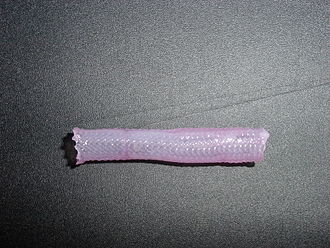
Tissue engineered vascular graft
組織工程血管移植
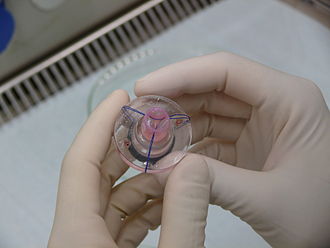
Tissue engineered heart valve
組織工程心臟瓣膜
A
number of different methods have been described in literature for preparing
porous structures to be employed as tissue engineering scaffolds. Each of these
techniques presents its own advantages, but none are free of drawbacks.
有許多製備用於組織工程支架的多孔結構,
的不同的方法已經在文獻中被描述了.
每個這些技術呈現其自身的優點,
但沒有一個是沒有缺點的.
Nanofiber Self-Assembly奈米纖維自組裝
Molecular self-assembly is one of the few methods for creating biomaterials with
properties similar in scale and chemistry to that of the natural in vivo
extracellular
matrix (ECM), a crucial step toward tissue engineering of complex tissues.
[20]
Moreover, these hydrogel scaffolds have shown superiority in in vivo toxicology
and
biocompatibility compared to traditional macro-scaffolds and animal-derived
materials.
分子自組裝是製造具有與天然的體內細胞外基質(ECM)
相似的尺度及化學的性質
的生物材料的少數方法之一,
是進行複雜組織的組織工程的關鍵步驟.
[20]
而且,
這些水凝膠的支架,
相較於傳統巨集支架和動物衍生 材料,
已顯示在體內毒
理學和生物相容性的優越性.
Textile technologies
紡織技術
These techniques include all the approaches that have been successfully
employed for the preparation of non-woven meshes of different polymers.
In
particular, non-woven polyglycolide structures have been tested for tissue
engineering applications: such fibrous structures have been found useful to grow
different types of cells.
The
principal drawbacks are related to the difficulties in obtaining high porosity
and regular pore size.
這些技術包括所有已經成功用於製備不同聚合物的非織造網眼的方法.
特別是,
非織造聚乙交酯結構已經測試過組織工程的應用:例如已發現纖維結構於
生長不同類型的細胞是有用的.
主要缺點是有關於獲得高的孔隙率及規則孔徑的難度.
Solvent Casting & Particulate Leaching (SCPL)
溶劑鑄造/鹽粒浸出
This approach allows for the preparation of structures with regular porosity, but
with
limited thickness.
First, the polymer is dissolved into a suitable organic solvent (e.g.
polylactic acid could be dissolved into dichloromethane),
then the solution is
cast
into a mold filled with porogen particles.
這個方法允許用於具有規則孔隙率結構的製備,
但具有有限的厚度.
首先,
聚合物被溶解到適當的有機溶劑(如聚乳酸可以溶解到二氯甲烷),
然後將
溶液是澆鑄到充滿致孔隙原顆粒的模具內.
Such
porogen can be an inorganic salt like sodium chloride,
crystals of
saccharose,
gelatin spheres or paraffin spheres.
The
size of the porogen particles will affect the size of the scaffold pores,
while
the polymer to porogen ratio is directly correlated to the amount of porosity
of
the final structure.
這樣的孔隙原可以是像氯化鈉的無機鹽,
晶體蔗糖,
明膠球或石蠟球.
孔隙原顆粒的大小會影響到支架的孔隙的大小,
而聚合物與孔隙原的比率直接關係
到最終結構的孔隙的量.
After
the polymer solution has been cast the solvent is allowed to fully
evaporate, then the composite structure in the mold is immersed in a bath of a
liquid suitable for dissolving the porogen: water in the case of sodium
chloride,
saccharose and gelatin or an aliphatic solvent like hexane for use with paraffin.
在聚合物溶液以經被澆鑄之後,
溶劑被允許完全蒸發,
然後這模型裏的複合結構被
浸在適於溶解所述孔隙原的液體浴裏:在氯化鈉,
蔗糖和明膠的情況下是用水,
或
像己烷用於石蠟
族溶劑的情況.
Once
the porogen has been fully dissolved, a porous structure is obtained.
Other
than the small thickness range that can be obtained, another drawback of
SCPL
lies in its use of organic solvents which must be fully removed to avoid any
possible damage to the cells seeded on the scaffold.
一旦孔隙原被充分溶解,
一種多孔結構得到了.
除了可以得到的小的厚度範圍,
SCPL的另一缺點在於其有機溶劑的使用,
它必須
被充分去除,
以避免對於接種在支架上的細胞的任何可能的損壞.
Gas Foaming
氣體發泡
To overcome the need to use organic solvents and solid porogens, a technique
using gas as a porogen has been developed.
First, disc-shaped structures made of the desired polymer are prepared by means
of compression molding using a heated mold.
The discs are then placed in a chamber where they are exposed to high pressure CO2 for several days.
為了克服使用有機溶劑和固體孔隙原的需要,
使用氣體作為孔隙原的技術已被開發出來.
首先,
使所需聚合物的圓盤狀結構經由使用加熱模具壓縮成形的方法製備.
圓盤然後被放置在一個腔室內,
在那裡它們被暴露於高壓二氧化碳幾天.
The pressure inside the chamber is gradually restored to atmospheric levels.
During this procedure the pores are formed by the carbon dioxide molecules that
abandon the polymer, resulting in a sponge-like structure.
The main problems resulting from such a technique are caused by the excessive
heat used during compression molding (which prohibits the incorporation of any
temperature labile material into the polymer matrix) and by the fact that the
pores do not form an interconnected structure.
腔室內部的壓力逐漸恢復到大氣壓水平.
在此過程中孔的形成是由二氧化碳分子脫離了該聚合物, 造成海綿狀結構構.
從這樣的技術所產生的主要問題是由於壓縮成形(它禁制了的任何溫度不穩定材料加入聚合物基質中)中過多使用的熱量,
以及由於一個事實,
即孔不形成相互連接的結構所造成的.
Emulsification/Freeze-drying
乳化/冷凍乾燥
This technique does not require the use of a solid porogen like SCPL.
First, a synthetic polymer is dissolved into a suitable solvent (e.g. polylactic
acid in dichloromethane) then water is added to the polymeric solution and the
two liquids are mixed in order to obtain an emulsion.
Before the two phases can separate, the emulsion is cast into a mold and quickly
frozen by means of immersion into liquid
nitrogen.
The frozen emulsion is subsequently freeze-dried to remove the dispersed water and the solvent, thus leaving a solidified, porous
polymeric structure.
這種技術不需要使用像SCPL的固體的孔隙原.
首先,
將合成的聚合物溶解到適當的溶劑 (例如,
聚乳酸在二氯甲烷),
然後將水加入到聚合物溶液中,
將兩種液體混合,
以獲得一種乳液.
在兩相分開以前,
這乳液被澆鑄到模具中,
並浸泡在入液氮內被迅速地冷凍.
這冷凍的乳液隨後被冷凍乾燥以除去散佈的水和溶劑,
從而留下一個固化的,
多孔的聚合結構.
While emulsification and freeze-drying allow for a faster preparation when
compared to SCPL (since it does not require a time consuming leaching step), it
still requires the use of solvents.
Moreover, pore size is relatively small and porosity is often irregular.
Freeze-drying by itself is also a commonly employed technique for the
fabrication of scaffolds. In particular, it is used to prepare collagen sponges:
collagen is dissolved into acidic solutions of acetic
acid or hydrochloric
acid that are cast into a mold, frozen with liquid nitrogen and then lyophilized.
雖然相較於SCPL(因為它不需要耗時浸出步驟),
乳化和冷凍乾燥允許更快的製備,
但仍需要使用溶劑.
此外,
孔尺寸是比較小的,
而孔隙率通常是不規則的.
冷凍乾燥本身也是一種常用於支架製造的技術.
特別地,
它是用於製備膠原海綿:膠原被溶解到乙酸或鹽酸的酸性溶液,
被澆鑄到模具中,
用液氮冷凍,
然後冷凍乾燥.
Thermally Induced Phase Separation (TIPS)
熱致相分離
Similar to the previous technique, this phase separation procedure requires the
use of a solvent with a low melting point that is easy to sublime.
For example dioxane could
be used to dissolve polylactic acid, then phase separation is induced through
the addition of a small quantity of water: a polymer-rich and a polymer-poor
phase are formed.
Following cooling below the solvent melting point and some days of vacuum-drying
to sublime the solvent, a porous scaffold is obtained.
Liquid-liquid phase separation presents the same drawbacks of
emulsification/freeze-drying.
類似於前面的技術中,
這種相分離程序需要使用具有低的熔點,
容易昇華的溶劑.
例如dioxane可用於溶解聚乳酸,
然後相分離是經由加入少量的水引起的:形成了一富含聚合物和少含聚合物的相.
在低於溶劑熔點以下冷卻和真空乾燥一些日子以昇華溶劑,
獲得了多孔的支架.
液-液相分離呈現與乳化/冷凍乾燥相同的缺點.
Electrospinning
靜電紡絲
A highly versatile technique that can be used to produce continuous fibers from
sub-micrometer to nanometer diameters.
In a typical electrospinning set-up, a solution is fed through a spinneret and a
high voltage is applied to the tip.
The buildup of electrostatic repulsion within the charged solution, causes it to
eject a thin fibrous stream.
A mounted collector plate or rod with an opposite or grounded charge draws in
the continuous fibers, which arrive to form a highly porous network.
The primary advantages of this technique are its simplicity and ease of
variation.
是一個高度彈性使用的技術,
可用於生產從亞微米至奈米的直徑的連續纖維.
在一個典型的電紡設置,
一個溶液通過噴絲頭進料,
以及一個高電壓被施加到尖端.
在充電溶液內堆積的靜電斥力,
使其噴射出薄纖維串流.
所安裝的一個具有相反或接地電荷的集電板或棒,
引出連續纖維,
它達到高度多孔的網絡成形.
這個技術的主要優點在於其簡單和 容易調變.
At a laboratory level, a typical electrospinning set-up only requires a high
voltage power supply (up to 30 kV), a syringe, a flat tip needle and a
conducting collector.
For these reasons, electrospinning has become a common method of scaffold
manufacture in many labs.
By modifying variables such as the distance to collector, magnitude of applied
voltage, or solution flow rate—researchers can dramatically change the overall
scaffold architecture.
在實驗室水準,
一個典型的電紡的設置僅需要一個高壓電源(高達30千伏),
一個注射器,
一個平頭的針和導電集電器.
由於這些原因,
靜電紡絲,
成為在許多實驗室裏,
常用的支架製造方法.
通過修改變量,
如集電器的距離,
施加電壓的大小,
或溶液流速,
研究人員可以顯著改變整體支架結構.
CAD/CAM Technologies
CAD / CAM的技術
Because most of the above techniques are limited when it comes to the control of
porosity and pore size, computer assisted design and manufacturing techniques have been introduced to tissue engineering.
First, a three-dimensional structure is designed using CAD software. The
porosity can be tailored using algorithms within the software.[21]
The scaffold is then realized by using ink-jet printing of polymer powders or
through Fused Deposition Modeling of a polymer melt.[22]
因為大多數的上述技術,
當涉及到的孔隙率和孔尺寸的控制是受限的,
計算機輔助設計和製造技術已被引入到組織工程.
首先,
三維結構體被是使用CAD軟件設計.
孔隙率可使用軟體內的演算法來調整. [21]
這支架接著使用的聚合物粉末的噴墨列印或經由聚合物熔體的熔融沉積成型來實現. [22]
A 2011 study by El-Ayoubi et al. investigated "3D-plotting technique to produce
(biocompatible and biodegradable) poly-L-Lactide macroporous scaffolds with two different pore sizes" via solid
free-form fabrication (SSF) with computer-aided-design (CAD), to explore
therapeutic articular cartilage replacement as an "alternative to conventional tissue repair".[23]
一個2011年由El-Ayoubi等人的研究.
調查了“3D-繪圖技術生產(生物相容的和可生物降解的)有兩個不同的孔徑大小的聚-L-丙交酯的大孔的支架” 經由固體自由形式加工(SSF)與計算機輔助設計(CAD),
以探索治療的關節軟骨替換做為“傳統組織修復的替代方式. ”[23]
The study found the smaller the pore size paired with mechanical stress in a
bioreactor (to induce in vivo-like conditions), the higher the cell viability in potential
therapeutic functionality via decreasing recovery time and increasing transplant
effectiveness.[23]
研究發現在一個生物反應器中與機械應力配對的孔徑愈小
(以誘導如同體內的條件),
細胞在經由減少恢復時間以及提高移植效果的潛在治療功能的可行性愈高. [23]
Laser-assisted BioPrinting
(LaBP)
雷射輔助生物列印
In a 2012 study,[24] Koch et al. focused on whether Laser-assisted BioPrinting (LaBP) can be used to
build multicellular 3D patterns in natural matrix, and whether the generated
constructs are functioning and forming tissue.
LaBP arranges small volumes of living cell suspensions in set high-resolution
patterns.[24]
在2012年的研究中, [24] Koch等.
聚焦在雷射輔助生物列印(LaBP)是否可用於以天然基質建構多細胞三維樣式 ,
以及所生成的構建體是否能運作並形成組織.
LaBP排列小體積的活細胞懸浮液在設置的高解析度樣式中. [24]
The investigation was successful, the researchers foresee that "generated tissue
constructs might be used for in
vivo testing by implanting them into animal
models" (14).
As of this study, only human skin tissue has been synthesized, though
researchers project that "by integrating further cell types (e.g. melanocytes, Schwann
cells, hair follicle cells) into the printed cell construct, the behavior of these
cells in a 3D in vitro microenvironment similar to their natural one can be analyzed", useful for drug discovery and toxicology studies.[24]
此調查是成功的,
研究人員預見“所產生的組織構建物經由植入動物模型,
可能用於體內測試”(14).
截至這項研究為止,
只有人類皮膚組織已經被合成的,
雖然研究預測, ”經由整合更進一步的細胞類型(例如黑素細胞,
雪旺氏細胞,
毛囊細胞)到列印的細胞構,
這些細胞在類似於其天然的三維體外微環境的行為可以被分析”,
用於藥物開發和毒理學研究是有用的. [24]
Assembly methods
組裝方法
One of the continuing, persistent problems with tissue engineering is mass
transport limitations.
Engineered tissues generally lack an initial blood supply, thus making it
difficult for any implanted cells to obtain sufficient oxygen and nutrients to
survive, and/or function properly.
持續的,
長期存在的組織工程問題之一是質量輸送的限制.
工程化的組織通常缺乏初始的血液供應,
因此使得對於任何植入的細胞要獲得足夠的氧和營養物質以生存和/或正常工作是困難的.
Self-assembly
自組裝
Self-assembly may play an important role
here, both from the perspective of encapsulating cells and proteins, as well as
creating scaffolds on the right physical scale for engineered tissue constructs
and cellular ingrowth.
The micromasonry is a prime technology to get cells
grown in a lab to assemble into three-dimensional shapes.
從細胞和蛋白質的包封,
以及為了正確物理尺度的
工程化組織構建和細胞向內生長所製造的支架,
的兩個觀點,
自組裝在這裏都可發揮重要的作用.
Micromasonry是獲得在實驗室生長的,
用來組裝成三維形狀的細胞基本技術
To break down tissue into single-cell building blocks, researchers have to
dissolve the extracellular mortar that normally binds them together.
But once that glue is removed, it's quite difficult to get cells to reassemble
into the complex structures that make up our natural tissues.
While cells aren't easily stackable, building blocks are. So the micromasonry starts with the encapsulation of
living cells in polymer cubes. From there, the blocks self-assemble in any shape
using templates.
要把組織分解成單細胞組件,
研究人員必須溶解通常將它們結合在一起的細胞外的附合物.
但一旦膠水被移除了,
這是相當難以讓細胞重新組合成組成我們的天然組織的複雜結構.
雖然細胞不容易是可堆疊的,
組件是可以的.
所以micromasonry以在聚合物立方體內的活細胞的封裝開始.
從那裡,
這些組件使用模板自組裝成任何形狀.
Liquid-based template assembly
基於液體的模板裝置
The air-liquid surface established by Faraday
waves is
explored as a template to assemble biological entities for bottom-up tissue
engineering.
This liquid-based template can be dynamically reconfigured in a few seconds, and
the assembly on the template can be achieved in a scalable and parallel manner.
由法拉第波建立的空氣
-
液體表面被探索作為自下而上組織工程的生物實體組裝的模板.
這種基於液體的模板可以在幾秒內被動態地重新配置,
在且模板上的組件可以一個可擴展的和平行的方式來達成.
Assembly of microscale hydrogels, cells, neuron-seeded micro-carrier beads, cell
spheroids into various symmetrical and periodic structures was demonstrated with
good cell viability.
Formation of 3D neural network was achieved after 14-day tissue culture.[25]
組合微尺度水凝膠,
細胞,
神經元種子微載體珠,
細胞球體成為各種對稱和週期性的結構被,證明具有良好的細胞的可行性.
三維神經網絡的形成是經過14天的組織培養來達成. [25]
Additive manufacturing
增材製造
It might be possible to print organs, or possibly entire organisms using additive manufacturing techniques.
A recent innovative method of construction uses an ink-jet mechanism to print
precise layers of cells in a matrix of thermoreversible gel.
Endothelial cells, the cells that line blood vessels, have been printed in a set
of stacked rings. When incubated, these fused into a tube.[22][26]
使用增材製造的技術,
它有可能可以列印器官,
或者可能整個有機體.
一個最近創新的建構方法使用一噴墨機構以在熱可逆凝膠的基質內列印精確層次的細胞.
內皮細胞,
這細胞排力列於血管中,
已被列印成一組層疊的環.
經過培育後,
這些融合成一個管. [22] [26]
The field of three-dimensional and highly accurate models of biological systems
is pioneered by multiple projects and technologies including a rapid method for
creating tissues and even whole organs involves a 3D printer that can print the
scaffolding and cells layer by layer into a working tissue sample or organ.
三維和高度精確的生物系統模型的領域由多個計劃項目和技術所開創,
包括一個用於製作組織的快速方法,
以及
甚至整個器官涉及可以通過逐層列印支架和細胞到一個工作中的組織樣本或器官的三維列印機.
The device is presented in a TED
talk by Dr. Anthony Atala, M.D. the Director of the Wake Forest Institute
for Regenerative Medicine,
and the W.H. Boyce Professor and Chair of the Department of Urology at Wake Forest University, in which a full bladder is printed on stage during the
seminar and then presented to the crowd.[27][28]
這個設備由Anthony
Atala, M.D.博士,
在 Wake Forest再生醫學研究所主任,
和W.H. Boyce , Wake Forest大學泌尿外科系教授兼系主任,
在一個TED講座被呈現,
當中,
一個完整的膀胱是研討會期間被印出在平台上,
然後呈現給觀眾. [27] [28]
This specific technology has been used to print a bladder for a young man that
would have otherwise died without the availability of a transplant, and is anticipated to be able to print
kidneys and perhaps livers in the future for transplantation and theoretically
for toxicology and other biological studies as well.
這種特殊的技術已經被用於列印膀胱給一名年輕男子,
他如果沒有移植的可用性,
將會死亡,
並且在未來,
預計能夠列印腎臟和可能肝臟, 用於進行移植, 以及理論上用於進行毒理學和其他生物研究也是如此.
Scaffolding
支架
In 2013, using a 3-d scaffolding of Matrigel in various configurations, substantial
pancreatic organoids was produced in vitro.
Clusters of small numbers of cells proliferated into 40,000 cells within one
week.
The clusters transform into cells that make either digestive enzymes or hormones like insulin,
self-organizing into branched pancreatic organoids that resemble the pancreas.[29]
The cells are sensitive to the environment, such as gel stiffness and contact
with other cells.
在2013年,
在各種配置中,
使用種Matrigel三維支架,
實質性的胰腺組織體在體外被製造出來.
小數量的細胞群在一周內增殖成為40,000個細胞.
群簇轉化成細胞,
使消化酶或類似激素的胰島素,
自組織成類似於胰腺的分歧的的胰腺組織體.
[29]
細胞是對環境敏感的,
如凝膠剛性,
以及並與其他的細胞的相接觸.
Individual cells do not thrive; a minimum of four proximate cells was required
for subsequent organoid development.
Modifications to the medium composition produced either hollow spheres mainly
composed of pancreatic progenitors, or complex organoids that spontaneously
undergo pancreatic morphogenesis and differentiation.
單個細胞不茁壯成長;
最小4個相鄰的細胞用於後續組織體的發展是需要的.
介質組合物的修改製造出主要由胰腺祖細胞組成的空心球,
或自發進行胰腺形態發生和分化的複雜組織體.
Maintenance and expansion of pancreatic progenitors require active Notch and FGF signaling,
recapitulating in vivo niche signaling interactions.[30]
The organoids were seen as potentially offering mini-organs for drug testing and
for spare insulin-producing cells.[29]
維持和擴展胰腺祖細胞需要活性的Notch和FGF信號發送,
重點地呈現體內適當為置的利交互信號發送.
[30]
這個組織體被視為是潛在地提供用於藥物測試和備用產生胰島素的細胞的小型器官.
[29]
Tissue culture
組織培養
In many cases, creation of functional tissues and biological structures in vitro requires extensive culturing to promote survival, growth and inducement of functionality.
In general, the basic requirements of cells must be maintained in culture, which
include oxygen, pH, humidity, temperature, nutrients and osmotic pressure maintenance.
在許多情況下,
在體外製作功能性組織和生物結構,
需要大量的培養,
以促進生存,
生長和功能的誘導.
在一般情況下,
必須在培養中必須保持細胞的基本需求,
其中包括氧,
pH值,
濕度,
溫度,
營養物和滲透壓的維護.
Tissue engineered cultures also present additional problems in maintaining
culture conditions.
In standard cell culture,diffusion is often the sole means of nutrient
and metabolite transport. However, as a culture becomes larger and more complex,
such as the case with engineered organs and whole tissues, other mechanisms must
be employed to maintain the culture, such as the creation of capillary networks
within the tissue.
組織工程化的培養也呈現在維持培養條件的其他問題.
在標準的細胞培養,
擴散往往是營養和代謝物的運輸的唯一方式.
然而,
當一個培養變得更大和更複雜的時後,
例如工程器官和整個組織的情況下,
其他的機制必須被用於維持培養,
如在組織內建立毛細管網絡.
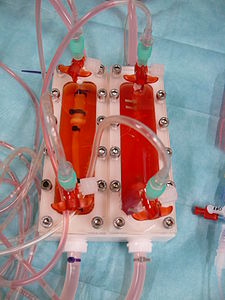
Bioreactor for cultivation of vascular grafts培養血管移植物的生物反應器
Another issue with tissue culture is introducing the proper factors or stimuli
required to induce functionality. In many cases, simple maintenance culture is
not sufficient.
Growth factors, hormones,
specific metabolites or nutrients, chemical and physical stimuli are sometimes
required.
另一個組織培養的問題是引入
誘導功能所需的適當的因素或刺激.
在許多情況下,
簡單維護的培養是不夠的.
生長因子,
激素,
特定代謝物或營養物,
化學和物理的刺激,
有時是需要的.
For example, certain cells respond to changes in oxygen tension as part of their
normal development, such as chondrocytes,
which must adapt to low oxygen conditions or hypoxia during
skeletal development.
Others, such as endothelial cells, respond to shear
stress from
fluid flow, which is encountered in blood
vessels. Mechanical stimuli, such as pressure pulses seem to be beneficial to all kind
of cardiovascular tissue such as heart valves, blood vessels or pericardium.
例如,
某些細胞回應氧分壓作為其正常發展的一部分,
如軟骨細胞,
在骨骼發育期間必須適應低氧條件或缺氧反應.
其他,
如內皮細胞,
回應來自流體流動的剪切應力,
這在血管中遇到.
機械刺激,
如壓力脈衝似乎是對所有類型的心血管組織是有益的,
如心臟瓣膜,
血管或心包膜.
Bioreactors生物反應器
Main article: Bioreactor主要文章:生物反應器
A
bioreactor in tissue engineering, as opposed to industrial bioreactors, is a
device that attempts to simulate a physiological environment in order to promote
cell or tissue growth in vivo.
A physiological environment can consist of many different parameters such as
temperature and oxygen or carbon dioxide concentration, but can extend to all
kinds of biological, chemical or mechanical stimuli.
Therefore, there are systems that may include the application of forces or
stresses to the tissue or even of electrical current in two- or
three-dimensional setups.
在組織工程中的生物反應器,
相對於工業生物反應器,
是一種試圖模擬生理環境,
以促進體內細胞或組織生長的裝置.
生理環境可以包含許多不同的參數,
如溫度和氧氣或二氧化碳的濃度,
但可擴展到各種生物,
化學或機械刺激.
因此,
有系統可以包含對組織施加力或應力,
甚置是在二維或三維設置的電流.
In academic and industry research facilities, it is typical for bioreactors to
be developed to replicate the specific physiological environment of the tissue
being grown (e.g., flex and fluid shearing for heart tissue growth).[31]
Several general-use and application-specific bioreactors are also commercially
available, and may provide static chemical stimulation or combination of
chemical and mechanical stimulation.
在學術和工業研究機構,
生物反應器被開發用來複製所要生長的組織的特定生理環境是典型的.
(例如,
彎曲和流體剪切對心臟組織的生長).
[31]
幾個一般用途和特定應用的生物反應器,
也可商業化地取得,
並且可以提供靜態化學刺激或化學和機械性刺激的組合.
The Bioreactors used for 3D cell cultures are small plastic cylindrical chambers with regulated
internal humidity and moisture specifically engineered for the purpose of
growing cells in three dimensions.[32]
用於三維細胞培養物的生物反應器是小的塑料圓柱形腔,
有以三維生長細胞為目的內部濕度和水分調節的專門設計用.
[32]
The bioreactor uses bioactive synthetic materials such as polyethylene terephthalate membranes to surround the spheroid cells in an environment that maintains high
levels of nutrients.[19][33]
They are easy to open and close, so that cell spheroids can be removed for
testing, yet the chamber is able to maintain 100% humidity throughout.[34]
This humidity is important to achieve maximum cell growth and function.
這種生物反應器使用生物活性合成材料,
如聚對苯二甲酸乙酯膜,
以包圍球體的細胞賴一個維持高水平的營養物的環境中.
[19] [33]
它們很容易地打開和關閉,
從而使細胞球狀體可以被移開用於測試, 而這腔室能夠全程保持100%的濕度. [34]
此濕度是非常重要的,
以達到最大的細胞的生長和功能.
The bioreactor chamber is part of a larger device that rotates to ensure equal
cell growth in each direction across three dimensions.[34]
MC2 Biotek has
developed a bioreactor known as ProtoTissue[32] that uses gas
exchange to maintain high oxygen levels within the cell chamber; improving upon previous
bioreactors, because the higher oxygen levels help the cell grow and undergo
normal cell respiration.
[35]
這種生物反應器的腔室是一個較大的裝置,
它旋轉以確保在整個三維空間各方向的有相等的細胞生長.
[34]
MC2 Biotek
已經開發一稱為ProtoTissue
的生物反應器[32],
它使用氣體交換以保持細胞腔室中的高氧水平;
提升了以前的生物反應器,
因為更高的氧含量有助於細胞生長以及進行正常的細胞呼吸.
[35]
Long fiber generation長纖維的生產
In 2013, a group from the University of Tokyo developed cell laden fibers up to a
meter in length and on the order of 100 µm in size.[36]
These fibers were created using a microfluidic device that forms a double coaxial laminar flow.
在2013年,
一個來自日本東京大學的群組,
開發了細胞載貨纖維長度達1微米,
在100微米大小的級次. [36]
這些纖維是用可形成雙同軸層流的微流體裝置所製造
Each 'layer' of the microfluidic device (cells seeded in ECM, a hydrogel sheath, and finally a calcium chloride solution).
微流體裝置的每個'層'(接種在細胞外基質的細胞,
水凝膠鞘,
最後面是一氯化鈣溶液).
The seeded cells culture within the hydrogel sheath for several days, and then
the sheath is removed with viable cell fibers.
Various cell types were inserted into the ECM core, including myocytes, endothelial cells, nerve cell fibers,
and epithelial
cell fibers.
接種的細胞在水凝膠護套內培養數天,
然後將鞘與活細胞纖維除去.
各種細胞類型分別插入ECM核心,
包括肌細胞,
內皮細胞,
神經細胞纖維,
和上皮細胞纖維.
This group then showed that these fibers can be woven together to fabricate
tissues or organs in a mechanism similar to textile weaving.
Fibrous morphologies are advantageous in that they provide an alternative to
traditional scaffold design, and many organs (such as muscle) are composed of
fibrous cells.該小組這個群組隨後顯示,
這些纖維可以被編織在一起,
以類似紡織織造的機制製造組織或器官.
纖維的形態的優勢是在於它們提供一個傳統支架的替代設計,
而且許多器官(例如肌肉)是由纖維狀細胞組成的.
Bioartificial organs生物人工器官
An artificial organ is a man-made device that is implanted or integrated into a
human to replace a natural organ, for the purpose of restoring a specific
function or a group of related functions so the patient may return to a normal
life as soon as possible.
人造器官是一個人工製造的設備,
植入或整合到一個人以替換一天然器官,
以恢復一個特定的功能或一組相關的功能為目的,
因而患者可以盡快恢復到正常生活.
The replaced function doesn't necessarily have to be related to life support,
but often is.
The ultimate goal of tissue engineering as a discipline is to allow both 'off
the shelf' bioartificial organs and regeneration of injured tissue in the body.
被替換的功能不一定必須是相關於生命的維持,
但往往是.
組織工程作為一門學科的最終目標是達到”現成的”生物人工器官和在體內受傷組織的再生.
In order to successfully create bioartificial organs from a patients stem cells,
researchers continue to make improvements in the generation of complex tissues
by tissue engineering.
For example, much research is aimed at understanding nanoscale cues present in a
cell’s microenvironment.[20]
為了成功地從一個患者的幹細胞製造生物人工器官,
研究人員繼續以組織工程進行複雜組織的產生的改進.
例如,
許多研究的目的是了解存在於一個細胞的微環境的奈米級的線索.
[20]
See also另請參見
·
ECM Biomaterial
ECM生物材料
·
Biomedical engineering
Covidien公司
·
Biological engineering
生物醫學工程
·
Biomolecular engineering
生物分子工程
Molecular self-assembly
分子自組裝
·
Soft tissues
軟組織
·
Organ transplantation
器官移植
·
Tissue Engineering and Regenerative Medicine International Society
組織工程與再生醫學國際協會
·
National Institutes of Health
國家衛生研究院
·
National Science Foundation
美國國家科學基金會
·
National Research Council of Canada
加拿大國家研究評議會
·
Induced stem cells
誘導幹細胞
References
參考
·
Davis ME, Motion JP, Narmoneva DA, et al. (February 2005). "Injectable
self-assembling peptide nanofibers create intramyocardial microenvironments for
endothelial cells". Circulation 111 (4): 442–50. doi:10.1161/01.CIR.0000153847.47301.80.PMC 2754569. PMID 15687132.
·
Ma, Peter X. (May 2004). "Scaffolds for tissue fabrication". Materials Today: 30–40.
·
Holmes TC, de Lacalle S, Su X, Liu G, Rich A, Zhang S (June 2000). "Extensive
neurite outgrowth and active synapse formation on self-assembling peptide
scaffolds". Proc. Natl. Acad. Sci. U.S.A. 97 (12): 6728–33. Bibcode:2000PNAS...97.6728H.doi:10.1073/pnas.97.12.6728. PMC 18719. PMID 10841570.
·
Semino CE, Kasahara J, Hayashi Y, Zhang S (2004). "Entrapment of migrating
hippocampal neural cells in three-dimensional peptide nanofiber scaffold". Tissue Eng. 10 (3-4): 643–55. doi:10.1089/107632704323061997. PMID 15165480.
·
Mikos AG, Temenoff JS (2000). "Formation
of highly porous biodegradable scaffolds for tissue engineering" (PDF). Electronic Journal of Biotechnology 3: 114–9. doi:10.2225/vol3-issue2-fulltext-5.
·
National Science Foundation (U.S.A.) (2004). "The Emergence of Tissue Engineering as
a Research Field". Retrieved 28
April2006.
·
Nerem, R.M. (2000). Vacanti, Joseph; Lanza, R. P.; Langer, Robert S., ed. Principles of tissue engineering (2nd ed.). Boston: Academic Press. ISBN 0-12-436630-9.
·
{4. Fountain, Henry. A
First: Organs Tailor-Made With Body’s Own Cells. New york Times. 15 Sept. 2012.http://www.nytimes.com/2012/09/16/health/research/scientists-make-progress-in-tailor-made-organs.html?pagewanted=all&_r=0}
External links
外部鏈接
·
Clinical Tissue Engineering Center State of Ohio Initiative for Tissue Engineering (National Center for Regenerative
Medicine)
·
Pittsburgh Tissue Engineering Initiative
·
Tissue Engineering Society of Malaysia Pages
·
Tissue Engineering and Regenerative Medicine International Society
·
Tissue and Cell Engineering Society
·
Malaysia Tissue Engineering Laboratory Pages
·
Tissue engineering articles and information
·
Tissue Engineering Pages
·
Institute for Chemical Process and Environmental Technology Tissue engineered (TE) corneas
·
Organ Printing Multi-site NSF-funded initiative
·
Team Research Tissue Engineering and Medical Research Programmes
·
LOEX Center Université Laval
Initiative for Tissue Engineering
·
Dedicated issue of Philosophical
Transactions B on Tissue Engineering the Heart
·
Journal of Tissue Engineering
Translated By :
The Analytical Based Development Center
http://www.chromnet.net/Default.aspx
Email:
service@chromnet.net
LINE:service.abdc, SKYPE: skypeabdc, QQ: qqabdc(2220487599)
Zipcode:407
5th Floor, NO.641, Fu Shun Road, Shi-Tuen District , Taichung City, Taiwan,
R.O.C. 886-4-24628085, FAX:886-4-22569743
|